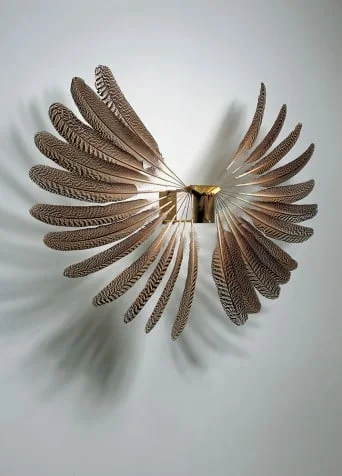FEMALE STUDY: REBECCA HORN'S COMMON THREAD
Still from: Unicorn (1970/72)
The reason I like The Cure is partly because no matter what song is playing, you can tell that it's them just by their sound. This is the kind of continuity I value in my own aesthetics as well. Underlying concepts create themes, which I build upon each time I make a new collection. But no matter what I make, it is similar to every other Bagtazo piece.
Artist Rebecca Horn has worked similarly throughout her life. Creating various works with the same logic, Horn develops her current work from the preceding. Elements may be readdressed, yet appear in totally different contexts. And somehow though none is quite like the other, you can see the common thread throughout her work.
White Body Fan, 1972
Rebecca Horn, born in Germany, lived much of her life in (the former West) Berlin. Starting her career in the 1970s with performances such as Body Extensions, Horn worked within the confines of femininity in order to push the boundaries of visual art.
Her Body Extensions work included many performances for film, that were re-performed at times. Building costumes that allowed for objects to protrude from her body, she moved about wearing these objects in attempt to "explore the equilibrium between body and space."
Still from: Touching the Walls with Both Hands Simultaneously (1974/75)
Often interested in simultaneity, Horn's common thread in the 1970s can be seen above in, Touching the Walls with Both Hands Simultaneously and below in one of my favorite performances for film, Cutting one's Hair with Two Scissors Simultaneously (1974). While the two performances are visually dissimilar, Horn is exploring the simultaneous use of both hands in unconventional ways.
Playing with scissors, Horn uses an ordinary object to explore her notions of 'body extension' and simultaneity. I really love this piece because of the subversive rebellion against femininity that is expressed by a woman cutting off her long hair. At times I don't believe Horn's scissors are sharp enough to even cut hair. And at the end of this piece, I get nervous she's going to miss and cut her eyelash. But when it's through we're left with her ambiguous expression covered with the two scissors. (The youtube comments on this video are hilarious also, fyi).
As the 70s pressed forward, Horn continued to explore costume and began incorporating her interest in wings and feathers, which is a theme she carried on from White Body Fan in the early 1970s through today.
"Feather Prison" costume still from Der Eintänzer (The Gigolo), 1978
Also playing with the ballet motif, Horn worked with ballerinas to create simultaneous movements while confined in the costumes she made to further explore simultaneity.
Der Eintänzer (1978)
From her work with simultaneity, Horn began exploring what she called 'kinetic sculptures' in the 1980s and 90s. This work applied the same concepts she used in Body Extensions, only where in Body Extensions the human body was the source of energy moving the objects she created, now the energy source was electronic kinetic movement. Much of this work was site-specific, and the artist chose culturally significant venues for their exhibitions whenever possible.
Also in 1991, Horn created High Moon (bottom left), which applied similar concepts as one of her Body Extensions sculptures, Overflowing Blood Machine, 1970 (bottom right). Since the 70s, Horn began making mechanical sculptures to bring motion to inanimate objects. The idea was to put human desire or movements that belong to the living into ordinary objects. At the time Overflowing Blood Machine was exhibited, Horn had a naked male wearing the suit, and the base of the 'machine' was filled with actual blood that flowed through the tubes. With High Moon, blood flows through tubes, into a reservoir before slowly dripping out of two rifles. In both pieces, the viewer is left to interoperate the significance of the blood.
Working in an era where the female artist laid claim to blood, the above two images are my two favorite comparisons of Horn's work. 20 years of building on the same concepts can lead to similar but different results. The common thread throughout Horn's work are her ideas. Motifs and the use of the same materials are what visually tie everything together, but without her core concepts, the common thread would not be the same.
Courtney Cady © Bagtazo, 2016







